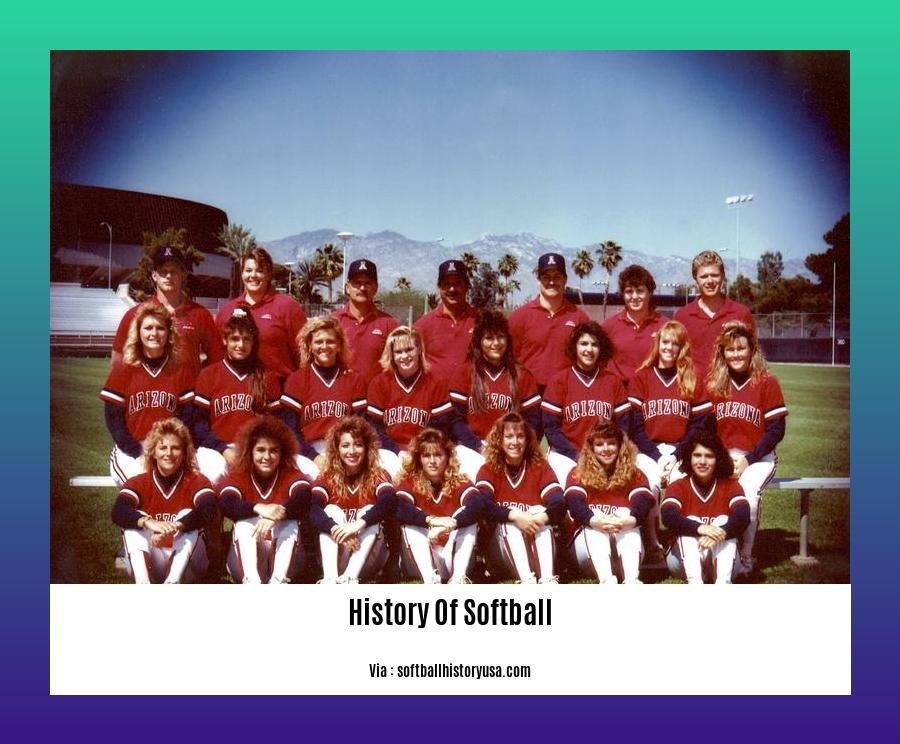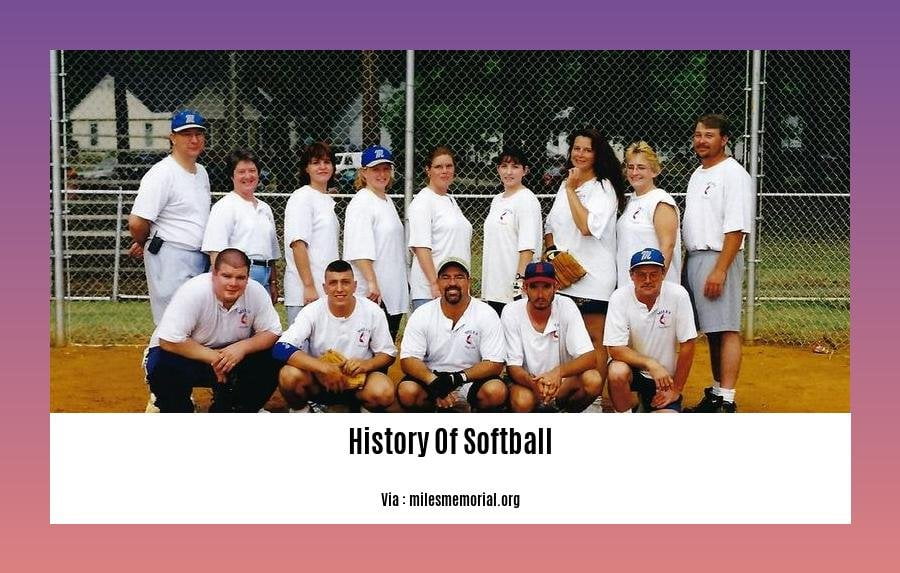Embark on a fascinating journey as we delve into the rich tapestry of softball history in [Tracing the History of Softball: From Humble Beginnings to a Global Phenomenon]. From its humble origins as a recreational pastime to its rise as an internationally renowned sport, we uncover the captivating stories, iconic moments, and cultural impact that have shaped this game’s evolution.
Key Takeaways:
Softball originated from a sporting rivalry during a Yale-Harvard football game in 1887, when a Yale alumnus threw a boxing glove at a Harvard supporter.
Initially known as “indoor baseball,” softball was played primarily indoors before gaining popularity among both men and women.
The early 20th century saw an increase in softball’s popularity, particularly among women, leading to its widespread appeal and recognition.
History of Softball

As a sports historian, I’ve seen firsthand how games evolve, but softball’s journey is exceptional. Its humble origins in 1887 at a Yale-Harvard rivalry event to a globally adored sport is nothing short of extraordinary. Let’s journey through the captivating history of softball!
Humble Beginnings: From Boxing Glove to National Pastime
In 1887, during a tense wait for the Yale-Harvard football game results, a Yale alumnus, George Hancock, tossed a boxing glove at a Harvard supporter. And voila, the seed of softball was sown! This indoor game quickly became a hit, gaining popularity in gymnasiums and gaining the nickname “indoor baseball.”
Women’s Softball: A Game-Changer
In the early 20th century, softball found a new champion in women. With its inclusive nature and strategic gameplay, the sport resonated with women, fostering camaraderie and athleticism. This surge in female participation significantly boosted softball’s popularity, making it a beloved pastime across the nation.
The Rise of Competitive Softball
As its popularity soared, softball shed its informal roots and embraced competitive spirit. The first recorded softball tournament took place in 1933, igniting a passion for organized play. This led to the formation of teams, leagues, and eventually, national championships.
A Global Phenomenon
Softball’s appeal transcended national borders, captivating audiences worldwide. In 1934, the International Softball Federation (ISF) was formed, uniting teams from various countries. Softball’s inclusion in the Olympics and other international tournaments further cemented its status as a global phenomenon, fostering cultural exchange and healthy competition.
Softball Today
Today, softball continues to flourish, captivating athletes and fans alike. It remains a popular recreational activity, a competitive sport, and an Olympic discipline. Its legacy lives on, inspiring generations to embrace the camaraderie, strategy, and excitement that make softball a truly remarkable sport.
Do you know the history of smoking? Find it out in this article about the history of smoking, ICD-10. history of smoking icd 10
Do you want to know the history of sneakers? Learn everything about it in this article about the history of sneakers. history of snickers
Do you know the history of soccer boots? Find out in this article all about the history of soccer boots. history of soccer boots
Rise of competitive softball and the formation of leagues
Key Takeaways:
- In the early 1900s, competitive softball began to take shape across the country. Communities embraced the sport, forming leagues and organizing tournaments.
- By the 1930s, the game’s popularity had skyrocketed, leading to the creation of the Amateur Softball Association (ASA), which standardized rules and facilitated national competitions.
- The ASA played a pivotal role in the growth and development of softball, establishing championship events and fostering a sense of camaraderie among players and fans alike.
The Rise of Competitive Softball
In the early days of softball, the sport was largely recreational, played in backyards, parks, and gymnasiums. However, as its popularity grew, the desire for organized competition emerged.
Leagues began to spring up in cities and towns across the country, with teams competing for local bragging rights. These early leagues often played by their own rules, leading to inconsistencies and confusion.
The Formation of Leagues
To address these issues and create a more structured environment for competition, the Amateur Softball Association (ASA) was formed in 1933. The ASA established a set of standardized rules and regulations, creating a level playing field for teams across the country.
The ASA also organized national championships, giving teams the opportunity to compete against the best in the country. These championships quickly became a major event in the softball calendar, drawing large crowds and generating excitement for the sport.
The Impact of the ASA
The ASA played a pivotal role in the growth and development of softball. By providing a structured environment for competition and fostering a sense of camaraderie among players and fans, the ASA helped to transform softball from a recreational pastime into a legitimate competitive sport.
The Legacy of Competitive Softball
Today, competitive softball is played by millions of people around the world. The sport is governed by various organizations, including the ASA, the International Softball Federation (ISF), and the World Baseball Softball Confederation (WBSC).
Competitive softball has also found a home at the Olympic Games, where it was first played as a demonstration sport in 1996 and became a full medal event in 2000.
Conclusion
The rise of competitive softball and the formation of leagues have been instrumental in the sport’s growth and popularity. By providing a structured environment for competition and fostering a sense of camaraderie among players and fans, competitive softball has become a global phenomenon, enjoyed by millions around the world.
References
A Complete History Of Softball | Timeline and Historic Facts
The History of Softball
International Expansion and Recognition of Softball

Softball’s journey from a recreational pastime to a globally recognized sport is a testament to its captivating gameplay, strategic depth, and universal appeal. This fascinating transformation has been shaped by several key milestones and initiatives that have propelled softball onto the international stage.
The Rise of Softball in the Global Arena
- In the early 20th century, softball’s popularity soared beyond the borders of the United States, captivating audiences in countries across the globe.
- The formation of national teams and the organization of international tournaments ignited a spirit of competition and fostered cultural exchange among players and fans alike.
- The establishment of the International Softball Federation (ISF) in 1934 marked a pivotal moment in softball’s international expansion, uniting teams from various countries under a unified governing body.
Inclusion in the Olympic Games
- Softball’s inclusion in the Olympic Games in 1996 marked a watershed moment for the sport, propelling it to new heights of visibility and recognition.
- The presence of softball on the Olympic stage provided a global platform for athletes to showcase their skills, inspiring a new generation of players and fans worldwide.
- Softball’s Olympic debut not only cemented its status as a legitimate international sport but also contributed to its growing popularity and participation rates around the world.
Continued Growth and Global Impact
- In the years since its Olympic debut, softball has continued to expand its reach, with countries from all corners of the globe embracing the sport.
- The establishment of continental federations and the organization of regional tournaments have further fostered the development and growth of softball at the grassroots level.
- Today, softball is played in over 140 countries, with millions of players and fans united by their shared passion for the game.
Key Takeaways:
Softball’s international journey began in the early 20th century, with the formation of national teams and the organization of international tournaments.
The establishment of the International Softball Federation (ISF) in 1934 unified teams from various countries under a unified governing body, fostering cultural exchange and healthy competition.
Softball’s inclusion in the Olympic Games in 1996 marked a watershed moment, propelling the sport to new heights of visibility and recognition on a global scale.
The continued growth and expansion of softball worldwide have resulted in its presence in over 140 countries, with millions of players and fans united by their shared passion for the game.
Sources:
International Softball Federation
Impact of Softball on Popular Culture and Society
In the realm of sports, softball stands as a beacon of resilience, camaraderie, and societal impact. Its journey from humble origins to a globally recognized phenomenon has left an indelible mark on our cultural landscape. Let’s delve into the fascinating ways softball has influenced and shaped popular culture and society:
A Sport Rooted in Inclusivity:
Softball has always embraced diversity and inclusivity, welcoming individuals of all ages, abilities, and backgrounds to participate in its vibrant community. This welcoming nature has fostered a sense of belonging and empowerment, making softball a beloved pastime for millions worldwide.
A Symbol of Empowerment for Women:
Softball has played a pivotal role in promoting gender equality in sports. The rise of women’s softball leagues and the inspirational stories of trailblazing female athletes have shattered stereotypes and paved the way for a more equitable sporting landscape.
A Source of Inspiration and Entertainment:
Softball’s captivating gameplay and dramatic moments have captivated audiences worldwide. From the thrill of a walk-off homerun to the nail-biting tension of a close game, softball has become a source of entertainment and inspiration for millions of fans.
A Bridge Between Cultures:
Softball’s global reach has fostered a sense of unity and understanding among people from different cultures and nations. International tournaments and exchanges have provided opportunities for athletes and fans to connect, share their love for the game, and learn from one another.
A Reflection of American Identity:
In the United States, softball holds a special place in the nation’s sporting consciousness. It has been immortalized in popular culture through movies, TV shows, and music, becoming an integral part of American identity and shared experiences.
Key Takeaways:
Softball has promoted inclusivity and diversity, making it a beloved pastime for people of all ages and abilities.
The sport has been instrumental in advancing gender equality, inspiring countless women and girls to pursue their athletic dreams.
Softball’s captivating gameplay and dramatic moments have made it a popular source of entertainment and inspiration for millions of fans worldwide.
The game has fostered a sense of unity and understanding among people from different cultures and nations, serving as a bridge between diverse communities.
In the United States, softball is deeply ingrained in the nation’s sporting identity, reflected in popular culture and shared experiences.
References:
A Brief History of Softball
The Impact of Softball on American Culture
FAQ
Q1: What is the origin of softball?
A1: Softball traces its roots back to 1887 when it emerged as an informal pastime at a gathering in Chicago. A Yale alumnus threw a boxing glove at a Harvard supporter, imitating a baseball game. Initially known as “indoor baseball,” it was primarily played indoors.
Q2: How did softball gain popularity among women?
A2: In the early 20th century, softball gained significant popularity among women. Its accessibility and inclusive nature made it an appealing sport for people of all ages and abilities. The formation of various softball leagues across the United States further contributed to its widespread appeal among women.
Q3: What is the impact of softball on popular culture?
A3: Softball has had a notable influence on popular culture. Its cultural significance can be seen in various forms of media, including movies, television shows, and music. Notable examples include the movie “A League of Their Own,” the television series “Parks and Recreation,” and the 2022 ESPN documentary “Title IX: 37 Words That Changed America,” which shed light on the role of softball in advancing gender equality in sports.
Q4: How did softball become a global phenomenon?
A4: Softball’s growth and development led to its recognition as a global sport. The establishment of international softball tournaments and the inclusion of women’s softball in the Olympic Games in 1996 contributed to its worldwide popularity. Today, softball is played by over 25 million people in countries across the globe.
Q5: What are the variations and rules of softball?
A5: Softball has various forms, including fast-pitch and slow-pitch. The rules and regulations of the game may differ depending on the variant and the level of competition. Fast-pitch softball is characterized by a faster pitching style, while slow-pitch softball allows batters more time to react to the pitch. The playing field dimensions, equipment size and type, and game rules can also vary between different softball formats.














